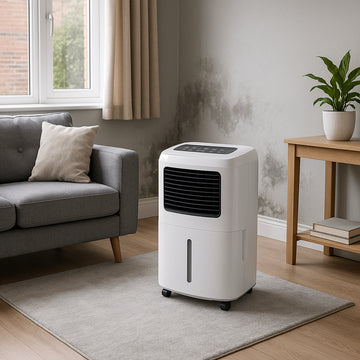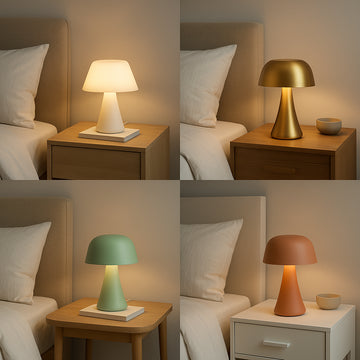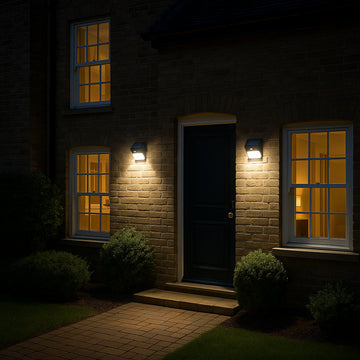High humidity in UK homes is a widespread issue that damages property and comfort.
But what exactly is a portable dehumidifier UK and how does it help?
This handy guide offers everything you need to confidently pick, use, and maintain the best portable dehumidifier for your space.
Some are compact yet powerful, ready to tackle damp spots quickly.
Some are smart-enabled, letting you control them from your phone.
Some come with laundry modes that speed up drying times dramatically.
Some are designed especially for the UK's damp climate and low temperatures.
Some use energy-efficient technology to keep running costs low.
Let's dive right in.
How do Portable Dehumidifiers Work and Why are They Essential in the UK?
Portable dehumidifiers remove excess moisture from the air. By drawing in humid air, cooling it to condense the water, and releasing drier air, they reduce dampness, mould, and condensation.
In the UK, the cold and wet climate means many homes suffer from humidity issues, especially in areas like bathrooms, kitchens, basements, and laundry rooms. Central heating, while warming, increases humidity indoors, raising the risk of mould and musty odours.
Using a portable dehumidifier creates a healthier, more comfortable environment by limiting mould growth, protecting furniture, and making rooms feel warmer.
According to industry experts, maintaining indoor humidity between 30-50% in winter and 40-60% in summer is ideal. Portable dehumidifiers help you achieve this balance with minimal fuss by continuously extracting moisture from the air where dampness is most concentrated [source].
Which Types of Portable Dehumidifiers are Best for UK Homes?
There are three main types: compressor (refrigerant), desiccant, and Peltier (thermoelectric) dehumidifiers. Each suits different needs and environments.
- Compressor Dehumidifiers use refrigerant coils cooled by a compressor to condense water from air. They're efficient in warm rooms above 15°C and are usually cost-effective. They extract large amounts of moisture daily, making them ideal for typical UK living spaces heated in winter.
- Desiccant Dehumidifiers rely on moisture-absorbing materials. They perform well in colder environments below 15°C, such as garages or conservatories. They tend to be quieter but consume more energy than compressors.
- Peltier Dehumidifiers are small, quiet, and energy-efficient but have limited capacity and only work well in smaller warm spaces, such as bedrooms. They're not suitable for heavy dampness.
For most UK homes facing typical indoor dampness, compressor or desiccant portable dehumidifiers are recommended, with compressors being more popular for heated rooms and desiccants for colder, less-used spaces [source].
How to Choose the Right Portable Dehumidifier Size for Your UK Home?
Choosing the correct size is crucial. It's not the unit’s physical size that matters most, but its capacity to remove moisture in 24 hours (usually measured in litres).
Experts advise planning based on your room size and dampness levels:
- Small rooms (up to 20 m²): 10-12 litre per day capacity;
- Medium rooms (20-40 m²): 15-20 litre per day capacity;
- Large areas or whole homes: 20-25 litre or more capacity.
If your home suffers from persistent moisture, or if you frequently dry laundry indoors, sizing up can make a big difference.
It's also helpful to factor in environmental conditions. More humid climates and spaces with more occupants or frequent water use might require a higher capacity unit.
Don’t overlook the water tank size of the dehumidifier. Larger tanks mean less frequent emptying, but many units offer continuous drainage options for extra convenience.
Want to dry your laundry faster? Look for models with dedicated laundry modes—they can cut drying times significantly, sometimes drying clothes in under four hours [source].
Where Should You Place Your Portable Dehumidifier for Best Results?
Placement critically affects performance. Ideally, position your dehumidifier near the problem area:
- Bathrooms that generate steam during showers;
- Kitchens with persistent cooking moisture;
- Basements prone to dampness;
- Laundry rooms, especially when drying clothes indoors.
Avoid placing the device too close to walls or furniture—leave around 30 cm of clearance to allow free airflow.
Interestingly, some models like the Meaco Arete Two are designed so you can place them closer to walls without losing efficiency, making them ideal for tight UK landing or hallway spaces [source].
Keep doors and windows closed when the dehumidifier is running to prevent fresh moist air from lowering effectiveness.
Best practice: Bring your laundry into the room with the dehumidifier rather than moving the dehumidifier from room to room. Let it create a dry zone that draws moisture in naturally.
Need a quick refresher on picking the right size dehumidifier? Here’s a helpful video explaining capacity and room size considerations:
How Much Does It Cost to Run a Portable Dehumidifier in the UK?
Operating costs depend on your chosen model and usage frequency. Compressor dehumidifiers typically use 150-500 watts per hour, while desiccants consume more but work better in cold conditions.
At current UK energy prices, expect running costs roughly between 5p and 15p per hour, depending on unit size and mode.
For example, the Pro Breeze OmniDry 20L model costs about 7p per hour to run at full power, making it one of the most economical large capacity units. Smaller units can cost even less, like the Honeywell 12L model which can cost roughly 4p per hour in laundry mode.
Also remember: maintaining your dehumidifier by cleaning filters regularly enhances efficiency and may reduce energy consumption.
Using your dehumidifier smartly—for instance, only when humidity exceeds your target, or with an adjustable humidistat—helps prevent wasting energy and adds to savings.
What Features Should You Look for in a Portable Dehumidifier?
Modern portable dehumidifiers offer a variety of features. Which ones matter most depend on your lifestyle, space, and preferences.
- Adjustable humidistat: Lets you set a target humidity level, so the device runs only when necessary.
- Continuous drainage option: Handy if you don’t want to empty the water tank frequently. You can connect a hose for constant drainage.
- Laundry mode: Speeds up drying times by boosting moisture extraction and airflow.
- Smartphone app control: Some models let you monitor and adjust settings remotely, even via voice assistants like Alexa or Google Home.
- Portability features: Handles, wheels, and light weights make moving the unit around easier.
- Noise levels: Especially for bedroom or office use, quieter units (under 40dB) are preferable.
- Air purification: A few units also filter dust and allergens, providing fresher indoor air.
- Child locks: Useful for homes with young children to prevent accidental setting changes.
For a blend of smart features, effective performance, and UK-focused design, look for reputable models like Pro Breeze, Meaco, and Devola, available with free UK delivery at Prime choice shop.
How to Use and Maintain Your Portable Dehumidifier Effectively
Correct operation and maintenance maximise performance and lifespan.
- Setting humidity level: Aim for 50-55% humidity indoors. Museums use around 55%, and it’s a good balance between comfort and mould prevention [source].
- Positioning: Keep about 30cm clearance around the unit.
- Emptying water tank: Do so regularly to prevent overflow. Many units shut off automatically when full.
- Cleaning the filter: Dust buildup reduces airflow and efficiency. Clean the inlet air filter every few months with a soft brush or vacuum.
- Running time: For heavy damp, continuous use up to 24 hours may be needed initially. Once target humidity is reached, 2-4 hours per day typically suffices.
- Air vents: Keep outlet clear of obstruction to maintain airflow.
- Annual maintenance: Wipe down exterior and check hoses or drainage connections.
Regular care will keep your unit energy-efficient and prolong its service life.
Can Portable Dehumidifiers Help with Laundry in UK Homes?
Absolutely. Drying clothes indoors during the often damp and chilly UK weather poses challenges.
Many portable dehumidifiers offer dedicated laundry modes that enhance moisture extraction and airflow — speeding drying times dramatically.
For example, the Pro Breeze 20L dehumidifier can dry a typical load in around 3-4 hours, cutting laundry air-drying times by more than half [source].
This benefit is a game changer for busy households, reducing reliance on tumble dryers and avoiding damp-related problems.
What Are the Best Portable Dehumidifiers for UK Homes in 2025?
Based on expert tests and user reviews, here are some popular and reliable picks you can consider:
| Model | Capacity (L/day) | Key Features | Price Range |
|---|---|---|---|
| Pro Breeze OmniDry 20L | 20 | Smart app control, laundry mode, quiet, compact | £150-£200 |
| Meaco Arete Two 20L | 20 | Air purifier function, quiet, easy to empty tank | £250-£350 |
| Devola 12L Compressor | 12 | Colour-changing humidity display, quiet, budget-friendly | £100-£120 |
| Honeywell 12L Portable | 12 | Simple to use, energy efficient, lightweight | £120-£150 |
| EcoAir DDWH10 | 10 | Wall-mount option, remote control, heater function | £180-£220 |
These models are known for balancing performance with energy efficiency and user convenience. Choosing one depends on your specific needs and budget. Shop with free UK delivery from Prime choice shop to add convenience to your purchase.
How Do I Install and Setup My Portable Dehumidifier?
Most portable dehumidifiers are straightforward to install and use right out of the box:
- Unpack and place the unit on a flat, stable surface in the desired room.
- Make sure there’s adequate clearance around it.
- Fill any water tanks if instructed (some units collect moisture directly).
- Plug it in and turn it on.
- Set your target humidity between 50-55% for optimal comfort and mould prevention.
- Choose additional modes such as laundry or sleep mode if available.
- Connect a continuous drainage hose if preferred for less tank emptying.
For smart units, download the app and follow pairing instructions for remote monitoring and control.
What Common Mistakes Should I Avoid When Using a Portable Dehumidifier?
Here are some pitfalls to watch out for:
- Not choosing the right capacity model for your room—underpowered units waste energy and won’t solve damp issues.
- Placing the dehumidifier too close to walls or furniture restricting airflow.
- Ignoring water tank emptying—letting it overflow or causing shutdown.
- Failing to clean air filters regularly, leading to inefficiency and noise.
- Operating with windows or doors open, making the machine work harder.
- Using mini Peltier models for large or very damp spaces—these have low capacities and won’t significantly reduce moisture.
Pro tip: When you first run your dehumidifier in a humid room, expect it to work continuously for 8-24 hours until a suitable humidity baseline is reached. After that, 2-4 hours daily is usually enough to maintain dryness.
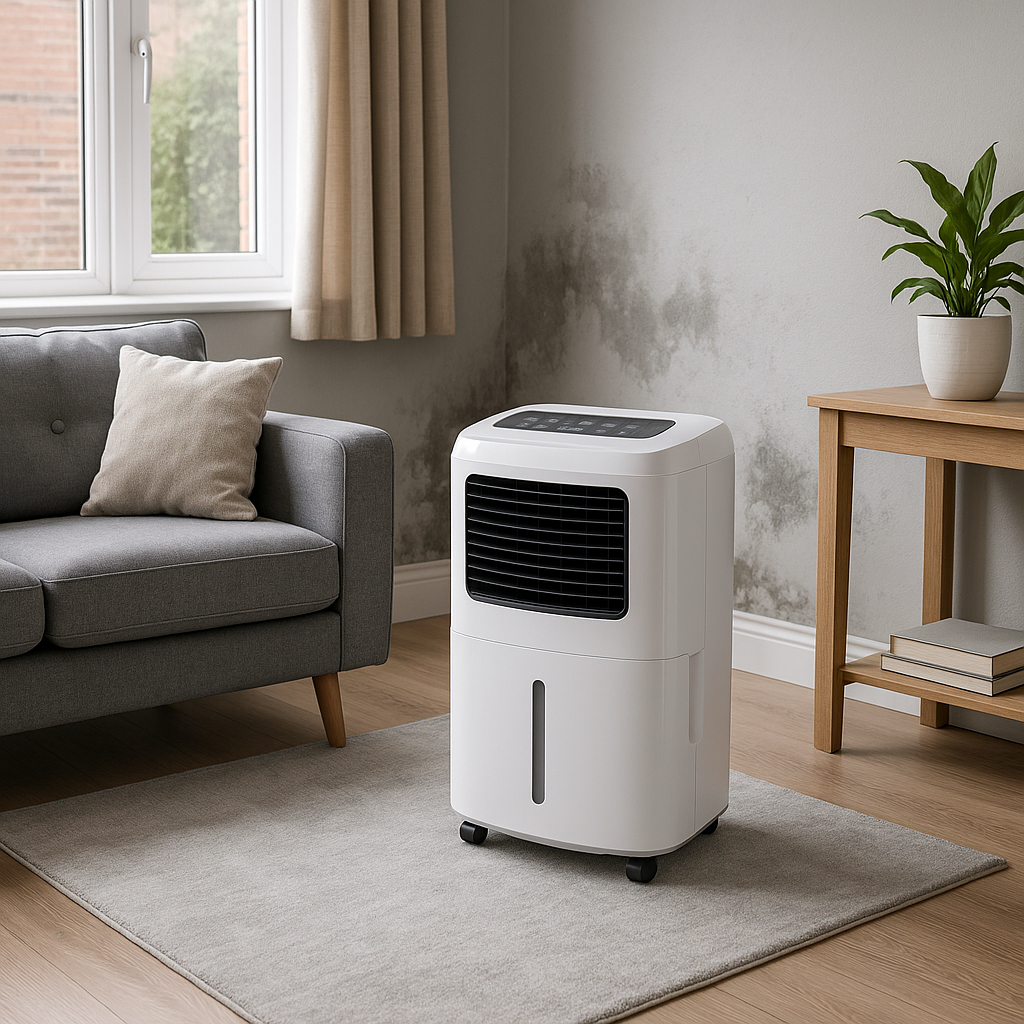
Why Are Some Portable Dehumidifiers Quieter Than Others?
Noise level varies by technology and design. Compressor models tend to generate more sound from their fans and compressors, typically 40-50 dB, comparable to a quiet office or washing machine.
Desiccant dehumidifiers usually operate more quietly but consume more power.
Models designed for bedrooms often prioritize noise reduction, some featuring sleep modes that reduce fan speed and noise.
When purchasing, check decibel (dB) ratings. Models under 35 dB are extraordinarily quiet, ideal for night use.
Can Portable Dehumidifiers Also Improve Indoor Air Quality?
Yes, some models include air purification features. By reducing humidity, they hinder mould and dust mite growth, which are common allergens.
Certain units, like the Meaco Arete Two 20L, also integrate air filters that trap dust and allergens, delivering fresher air alongside moisture control [source].
This dual function can alleviate allergy symptoms and create a healthier living environment.
What Is the Best Way to Troubleshoot My Portable Dehumidifier?
If your dehumidifier isn’t working properly:
- Check the water tank—is it full and needs emptying?
- Ensure the air filter is clean; clogged filters restrict airflow and cause reduced performance.
- Verify the unit is on a flat surface with proper clearance.
- Ensure windows and doors are closed and no new moisture is entering.
- Check settings, especially humidity targets and modes, to ensure they suit your needs.
- Refer to the manufacturer's manual for specific error codes or alerts.
- If the unit isn’t extracting moisture or is unusually noisy, consult warranty or customer support.
Remember, proper maintenance is key to preventing many common issues.
What Are UK Customers Saying About Portable Dehumidifiers?
UK users appreciate models designed for local conditions. Many highlight the effectiveness of units like Ebac and Meaco that are engineered with damp British homes in mind.
Features like laundry mode and app controls garner positive reviews for convenience and performance.
Energy efficiency and quiet operation are also crucial factors noted in customer Satisfaction.
Choosing a reliable brand with free UK delivery and UK-specific features ensures a smoother experience and peace of mind.
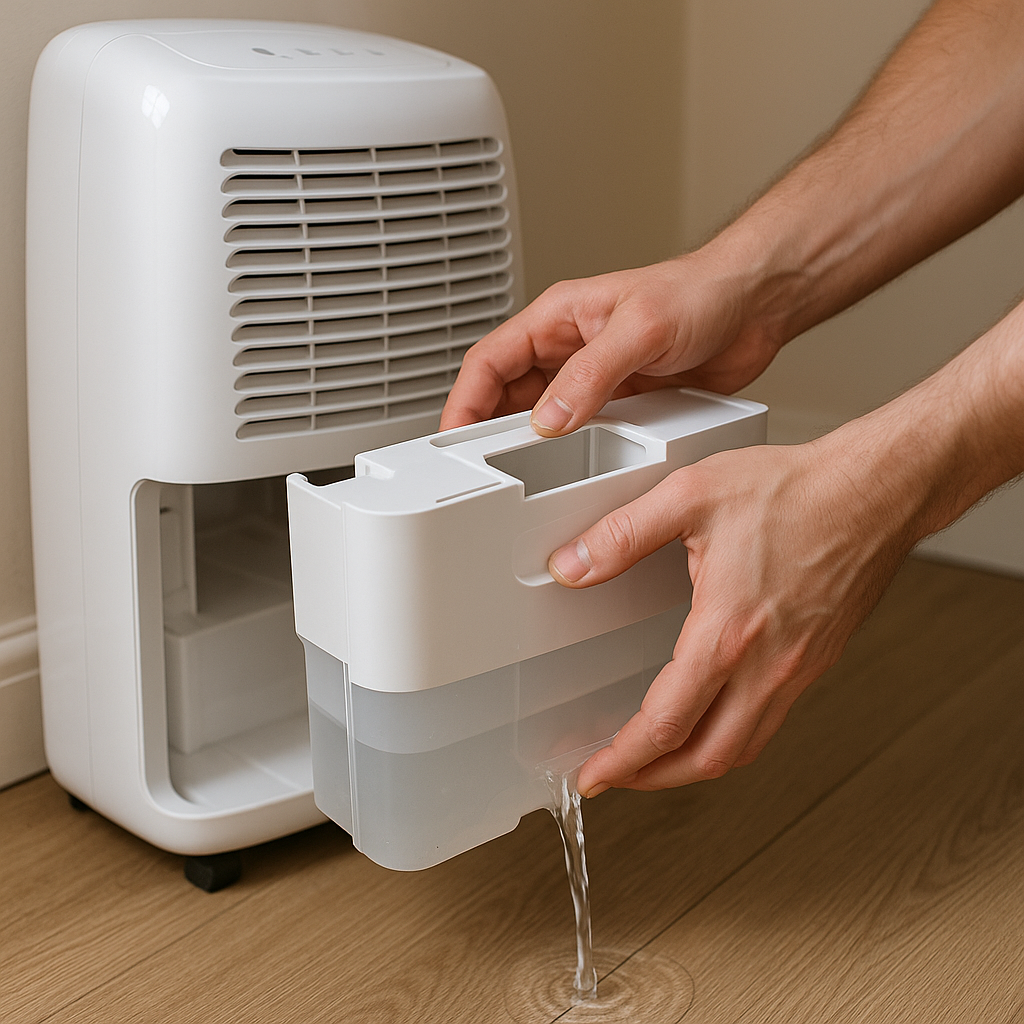
Summary of Key Tips for Buying a Portable Dehumidifier UK
- Choose the right dehumidifier type for your room temperature: compressor for warm/heated spaces, desiccant for colder areas.
- Match the unit capacity to your room size and dampness level, opting larger if you dry laundry indoors or have heavy moisture.
- Look for convenience features like continuous drainage and laundry modes.
- Consider noise levels if placing in bedrooms or living rooms.
- Regular maintenance extends lifespan and improves efficiency: clean filters and empty tanks often.
- Buy from trusted sellers offering free UK delivery to avoid delays and ensure warranty coverage.
If you want more expert advice on selecting home appliances, check our detailed post on choosing the best cordless vacuum for pet hair to see how we assess practical features and performance. Great tools make all the difference!
What's Your Next Step?
Tell us in the comments: How will you apply this to your home? For expert help discovering the perfect portable dehumidifier UK model and free delivery options, explore Prime choice shop now!
Frequently Asked Questions About Portable Dehumidifiers UK
- How often should I use my portable dehumidifier?
- If tackling heavy damp, run it continuously until humidity stabilizes, then 2-4 hours daily is usually sufficient.
- Are portable dehumidifiers safe for families with children?
- Yes, many come with child locks and safety cut-offs. Always follow manufacturer guidelines.
- Can a dehumidifier make my room cooler?
- No, dehumidifiers reduce moisture, which can make air feel fresher but they actually produce some warmth. They do not replace air conditioning.
- Is it better to use a desiccant or compressor dehumidifier in the UK?
- Both work well depending on room temperature. Desiccant units excel in cold, unheated spaces; compressors are best in heated rooms.
- How do I clean my dehumidifier?
- Regularly empty the tank, clean the air filter with a soft brush monthly, and wipe down the unit exterior periodically.
(Verified with sources as of 2025-10-02)


